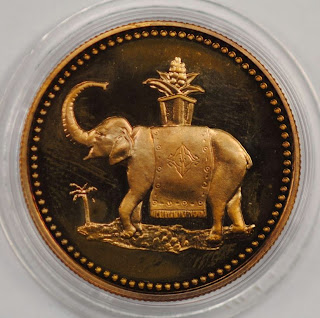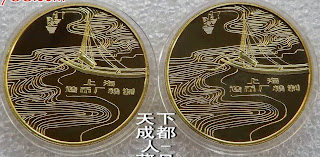By Haoyu Li
Shanghai Mint went through many changes after its establishment in 1920, but ever since its early days, there has been a very important position at Shanghai Mint – hand-engraving, which means directly engraving designs on steel dies. This position plays an important role at the mint. It is needed not only for the making and repairing all the hubs and dies in the facility, but is also an indispensable and important link in the entire production process.
Hand-engraving can be traced way back into history. In the old days, the master hubs for ancient Chinese coins were hand-engraved. Since its establishment, Shanghai Mint has witnessed five hand-engraver generations, from the first generation hand engraver Zhou Zhijun (1894-1937) who studied under Luigi George at Tianjin Mint, to the second generation masters Dong Yiqian and Tao Binglin, then to the well-known third generation hand-engravers Ye Bailin, Xian Zhaokun, Wei Yongming, Ye Zhonghua, Fang Maosen, Zeng Chenghu, Yi Shizhong, Gong Yiting, etc., and finally to the fourth and fifth generation teams of Lou Yufeng, Huang Zhiyi, Wang Junsong, etc. It can be claimed that the heritage has been well preserved and passed on from one generation to the next. The late 1970s and early 1980s were the peak of hand engraving at Shanghai Mint as well as across China. During this time, the third-generation hand engraving masters of Shanghai Mint worked together as well as completed with each other to create classic products that will last forever. The Palace Lantern series stands out as the best among these products, and is highly sought after by collectors. There are many designs and versions of the Palace Lantern series. Some are very hard to find. Many collector friends called me for information about them, and so I am offering a general summary, in an attempt to help them out.
So far four designs on the palace lantern side have been found, all with a diameter of 27 mm, as shown in the pictures below:
Figure One: palace lantern + 1980 date + Chinese and English Names of China Mint (with the font in regular script). The Chinese and English names of China Mint on this palace lantern design are rather crudely engraved. In fact, it should be understood that it is not easy to hand engrave Chinese characters. It is possible that this version of the palace lantern design was never released and has never been seen on the market just because the engraved characters were not up to the standard. It is kept internally at the Mint only. So no time will be spent discussing it.
The rarity rating is as follows. (★ is the lowest, and ★★★★★ the highest on the rarity scale.)
2. Palace Lantern with the Reverse Showing the Forbidden City's Corner Tower
See Figure 6 for Palace Lantern with the Corner Tower Reverse. The palace lantern obverse was hand engraved by Yi Shizhong, and the reverse was hand-engraved by Fang Maosen. I talked to Mr. Fang about this medal. He appeared very satisfied with the engraving of the corner tower of the Forbidden City. This should be Mr. Fang's prized work. Only a few specimens with the 1980 date are known to exist, which makes them very rare. Only the proof brass version is available. Gold-plated restrikes have never been encountered.
3. Palace Lantern with Auspicious Animals
The early Palace Lantern medals with the China Mint name on them are mostly proof medals made of brass, but they also have gold-plated versions. These gold-plated products from the 1980s are even rarer on the market than those without gold plating. Gold plating was used on high-end items at that time. I acquired one specimen by chance. The two characters Medal Pattern are written on the box. I have no idea what they exactly mean. See Figure 10.
Apart from these, there is also a set of "white" Palace Lantern medals. Some say they are made of 925 sterling silver, while others claim that the metal is white copper (copper-nickel alloy). Their weight is between 8 grams and 9 grams each. Further research is needed on the material. They are extremely rare on the market. See Figure 11.
Here is a summary of the rarity ratings of the different Auspicious Animals medals, based on different materials and versions.
The Palace Lantern series, with its auspicious implications, is highly prized by Chinese collectors. They are mostly hand-engraved, with exquisite designs. In the early days they were sold as high-end works of art. I once bought a set of two Palace Lantern medals, with an invoice attached from the Shanghai No. 1 Department Store. The No. 1 Department Store was one of the four major dealers of Shanghai Mint before the Franchised Dealership of Shanghai Mint went into operation. These two proof Palace Lantern brass medals with the 1980 date sold for as much as 11 yuan in 1981. See Figure 13. Considering the wage level at the time, it would be difficult for the Chinese to buy them. So many Palace Lantern series medals were sold overseas. Those with the 1980 date, in particular, are very rare in China, but they are relatively easy to acquire in other countries. They have become great options for both collection and investment.








































































